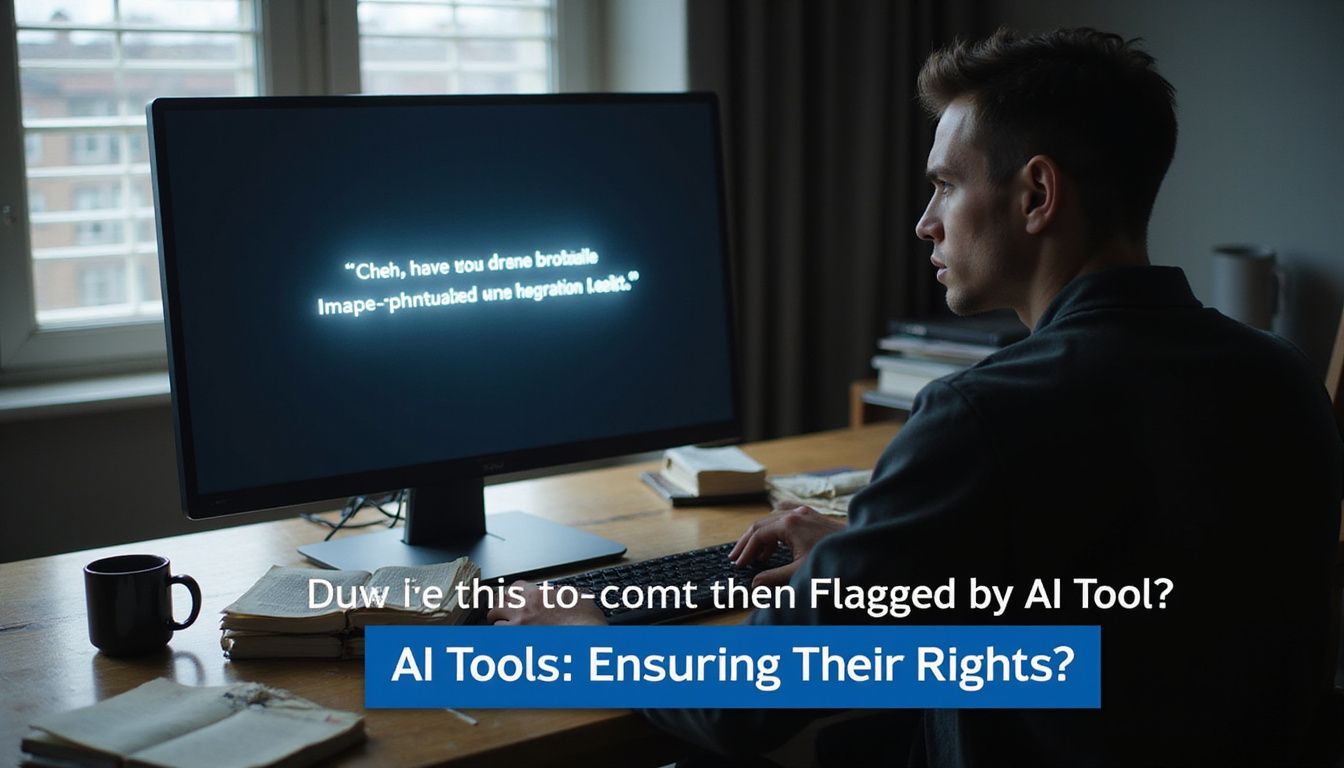Getting flagged by AI detection tools can feel unfair. Did you know students often face penalties based on tools that sometimes make mistakes? This post will explore the key question: do students have due process when flagged by AI tools? Stick around, because knowing your rights is vital.
Key Takeaways
- AI detection tools often make mistakes. Turnitin flagged 70 million assignments by August 2023, and about 4% were false positives. This hurts students’ academic records unfairly.
- Non-native English speakers face more bias from AI tools. Their writing styles are flagged as fake, even when the work is real. This shows a need for fairer systems in schools.
- Students have a right to due process when accused of dishonesty by AI. They deserve clear evidence and explanations before facing penalties like grade reductions or bans.
- Schools should not rely only on AI detectors. Teacher evaluations, drafts, and rubrics focusing on the writing process can reduce errors and ensure fairness for all students.
- Students can challenge false flags calmly. They should request proof, explain their writing steps, use version histories like Google Docs, and show earlier samples to prove originality.

Challenges with AI Detection Tools
AI detection tools can trip up, flagging honest work as fake. They might even carry hidden biases that hurt some students more than others.
Inaccuracy and False Positives
AI detection tools often misjudge human work as “ai-generated content.” Turnitin, for instance, flagged 70 million assignments by August 2023. Roughly 4% of these flags were mistakes, labeling real writing as fake.
Simple editing tools like Grammarly or brief texts under 300 words can trigger errors too. These false positives unfairly damage a student’s academic integrity and leave their record tarnished.
Mistakes like this do more than frustrate students; they carry serious consequences. A wrongly labeled assignment might lead to penalties for academic dishonesty or lower grades. Non-native English speakers are particularly at risk since their writing style may confuse the software’s judgment.
Such bias adds fuel to a growing debate about fairness in AI detection algorithms, leading us into questions about equity across education systems worldwide.
Bias in AI Algorithms
Bias against non-native English speakers has become a glaring issue with AI detection tools. These systems often flag writing as ai-generated content if it doesn’t match typical patterns of native language use, even when it’s authentic.
This puts students who speak English as a second language at an unfair disadvantage, creating red flags for ai use where none should exist. Such bias impacts academic integrity policies negatively and creates mistrust in the process.
Some educators rely on such tools without questioning their flaws, adding fuel to the fire. False positives are more likely when biases are embedded in AI algorithms or training data.
Academic dishonesty accusations based on flawed software can hurt students’ reputations and grades. To uphold fairness, schools must recognize these problems before taking action against flagged work.
Understanding these risks leads to protecting students’ rights under due process laws.
Understanding Students’ Rights
Students deserve fairness when accused of academic dishonesty by AI tools. They must know their rights and how to defend themselves properly.
Right to Due Process
Flagging students for academic dishonesty by AI detection tools can violate their right to due process. Due process means fair treatment, ensuring no one is punished without a chance to explain or defend themselves.
In September 2024, RNH’s parents filed a lawsuit claiming violations of this right. Schools rushed disciplinary actions based on AI reports even when errors occurred.
Students deserve clear evidence and explanations before facing penalties like bans or grade reductions. False positives from AI detectors often label original essays as ai-generated content, which harms innocent students.
This especially impacts non-native English speakers whose work may confuse such tools. Transparency in accusations leads into the next challenge: clarity in claims made against flagged students.
Transparency in Accusations
Clear accusations are vital in maintaining fairness. Students deserve to know why AI detection tools flagged their work as potentially ai-generated content. Without proper explanations, false positives caused by AI hallucinations can damage trust and harm academic integrity.
For example, teachers often rely on multiple detection tools like those used in RNH’s case, yet these systems sometimes show conflicting results.
Non-native English speakers may also face bias from AI algorithms that misinterpret their writing styles or grammar choices as red flags for AI use. Academic dishonesty should not be assumed based solely on software results.
Institutions must provide evidence and a clear reason supporting every accusation to protect students’ rights during the process.
Steps Students Can Take When Flagged
Stay calm, don’t panic. You have the right to question and defend your work when flagged by AI detectors.
Request Evidence and Explanation
Ask for clear proof if flagged by AI detection tools. Request your work’s revision history, which shows time spent writing or editing. For example, compare this to peers’ data to highlight differences.
Ask for specific flagged sections and their reasons. Stay polite while discussing concerns with instructors.
Calmly challenge vague accusations of academic dishonesty. Explain your writing process step by step. If allowed, offer to redo the assignment or complete an alternative task to show originality.
Prove Originality of Work
Use version history tools like Google Docs to show how your work developed step by step. This can highlight your writing process and prove the content is not ai-generated. Screen recordings during brainstorming or editing also serve as strong evidence.
Compare the flagged assignment with earlier writing samples. Teachers often notice patterns in a student’s style, especially for non-native English speakers. Avoid heated arguments; calmly present your proof, like drafts or saved files, to clarify doubts about academic dishonesty without conflict.
Building a Fairer System
Schools need better ways to check for academic dishonesty without relying only on AI. Clear rules and fair tools can protect both honesty and student rights.
Alternatives to AI Detection Tools
Peer review by educators can be a reliable option. Teachers who know their students’ writing styles may spot inconsistencies better than AI detection tools. This method reduces risks of false positives, especially for non-native English speakers or those using unique writing methods.
Rubrics that focus on the writing process rather than just the final submission also work well. For example, requiring drafts and outlines encourages original thought and limits chances of academic dishonesty.
These steps create transparency without depending heavily on ai-generated content detectors, leading to fairer outcomes for both students and teachers.
Ensuring Ethical Use of AI in Education
AI in education must be fair and transparent. Policies should clearly outline how AI detection tools are used, especially for spotting plagiarized or ai-generated content. Schools need to teach students about academic integrity and proper research methods, focusing on ethical writing practices instead of relying solely on technology.
Institutions should involve teachers, parents, and even non-native English speakers when shaping AI policy. This diverse input prevents bias in teaching methods or algorithms used by ai detectors.
Offices like ombudspersons can help clarify disputes over false accusations or red flags for ai use. Clear processes foster trust while protecting student rights.
Next: How to Start a Petition Against AI Detection Tools
How to Start a Petition Against AI Detection Tools
Changing unfair systems starts with action. A petition is a great way for students to voice concerns about AI detection tools in education.
- Write a Clear Goal
Explain why the petition exists in simple terms. Focus on issues like false positives, bias, or harm to non-native English speakers. Use strong language but remain respectful. - Research the Problem
Find data or stories showing flaws in AI detectors, such as cases of academic dishonesty flagged unfairly. Include examples affecting fairness in academic integrity policy discussions. Cite real concerns like AI hallucinations and biases harming students’ rights. - Choose Your Petition Platform
Use platforms like Change.org or local school forums to reach people faster. These sites make it easy to share and track supporters for your cause. - Call for Stakeholder Support
Speak with teachers, parents, or administrators who may share similar worries about how AI detection software is used. Their backing adds strength to your argument. - Spread the Word
Post about the petition on social media using hashtags related to academic honesty or artificial intelligence policies in schools. Share key points about critical thinking and writing process impacts caused by these tools. - Collect Stories from Others
Ask students for experiences dealing with red flags for AI use on their work; include how this hurt their education or learning process. - Propose Solutions
Suggest ethical alternatives such as teacher-led evaluations instead of relying solely on AI detection software. - Submit the Petition
Once you gather enough support, send it to decision-makers within your school or district’s curriculum board asking them to review their existing AI policy immediately.
Conclusion
AI tools in schools raise big questions about fairness and rights. Students flagged by these systems deserve clear evidence and a chance to explain their work. Schools must create fair policies, teach AI literacy, and avoid blind trust in detection software.
Change starts with open dialogue between students, teachers, and policymakers. Everyone’s voice matters in building a system that respects learning and justice.




